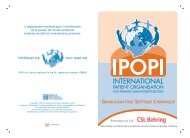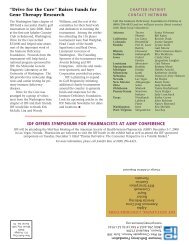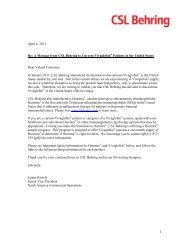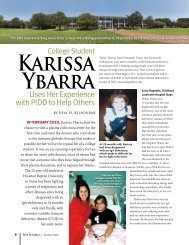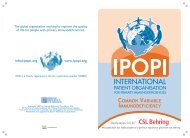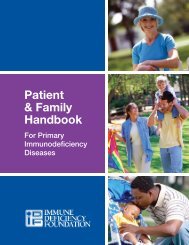7 Wiskott-Aldrich Syndrome - Immune Deficiency Foundation
7 Wiskott-Aldrich Syndrome - Immune Deficiency Foundation
7 Wiskott-Aldrich Syndrome - Immune Deficiency Foundation
Create successful ePaper yourself
Turn your PDF publications into a flip-book with our unique Google optimized e-Paper software.
chapter<br />
7 <strong>Wiskott</strong>-<strong>Aldrich</strong> <strong>Syndrome</strong><br />
<strong>Wiskott</strong>-<strong>Aldrich</strong> syndrome is a primary immunodeficiency disease<br />
involving both T- and B-lymphocytes. In addition, the blood cells that<br />
help control bleeding, called platelets are also affected. The classic form<br />
of <strong>Wiskott</strong>-<strong>Aldrich</strong> syndrome has a characteristic pattern of findings that<br />
include an increased tendency to bleed caused by a reduced number of<br />
platelets, recurrent bacterial, viral and fungal infections and eczema of<br />
the skin. With the identification of the gene responsible for this disorder,<br />
we now recognize that milder forms of the disease also occur that<br />
express some, but not all, of the above symptoms.
Definition of <strong>Wiskott</strong>-<strong>Aldrich</strong> <strong>Syndrome</strong><br />
In 1937, Dr. <strong>Wiskott</strong> described three brothers<br />
with low platelet counts (thrombocytopenia),<br />
bloody diarrhea, eczema and recurrent ear<br />
infections. Seventeen years later, in 1954, Dr.<br />
<strong>Aldrich</strong> demonstrated that this syndrome was<br />
inherited as an X-linked recessive trait (see chapter<br />
titled Inheritance). In the 1950s and 60s, the<br />
features of the underlying immunodeficiency were<br />
identified, and <strong>Wiskott</strong>-<strong>Aldrich</strong> syndrome joined<br />
the list of primary immunodeficiency diseases.<br />
<strong>Wiskott</strong>-<strong>Aldrich</strong> syndrome (WAS) is a primary<br />
immunodeficiency disease involving both T- and<br />
B-lymphocytes. Platelets—blood cells responsible<br />
for controlling bleeding—are also severely affected.<br />
In its classic form, WAS has a characteristic<br />
pattern of findings that include:<br />
1. Increased tendency to bleed caused by a<br />
significantly reduced number of platelets<br />
2. Recurrent bacterial, viral and fungal infections<br />
3. Eczema of the skin<br />
A reduced number of platelets of small size is a<br />
characteristic hallmark of all patients with WAS.<br />
Since WAS is the only disorder where small<br />
platelets are found, their presence is a useful<br />
diagnostic test for the disease. Bleeding into the<br />
skin caused by the thrombocytopenia may cause<br />
pinhead sized bluish-red spots, called petechiae, or<br />
they may be larger and resemble bruises. Affected<br />
<strong>Wiskott</strong>-<strong>Aldrich</strong> <strong>Syndrome</strong> 37<br />
In addition, long term observations of patients<br />
with WAS have revealed an increased incidence of<br />
malignancies, including lymphoma and leukemia,<br />
and an increased incidence of a variety of<br />
autoimmune diseases in many patients.<br />
The WAS is caused by mutations (or mistakes)<br />
in the gene which produce a protein named<br />
in honor of the disorder, the <strong>Wiskott</strong>-<strong>Aldrich</strong><br />
<strong>Syndrome</strong> Protein (WASP). The WASP gene is<br />
located on the short arm of the X chromosome.<br />
The majority of these mutations are “unique.”<br />
This means that almost every family has its own<br />
characteristic mutation of the WASP gene. If<br />
the mutation is severe and interferes almost<br />
completely with the gene’s ability to produce the<br />
WAS protein, the patient has the classic, more<br />
severe form of WAS. In contrast, if there is some<br />
production of mutated WAS protein, a milder form<br />
of the disorder may result.<br />
Clinical Presentation of <strong>Wiskott</strong>-<strong>Aldrich</strong> <strong>Syndrome</strong><br />
The clinical presentation of <strong>Wiskott</strong>-<strong>Aldrich</strong><br />
syndrome (WAS) varies from patient to patient.<br />
Some patients present with all three classic<br />
manifestations, including low platelets and<br />
bleeding, immunodeficiency and infection, and<br />
eczema. Other patients present with low platelet<br />
counts and bleeding. In past years, the patients<br />
who presented with just low platelet counts were<br />
felt to have a different disease called X-linked<br />
thrombocytopenia (XLT). After the identification<br />
of the WAS gene, it was realized that both the<br />
WAS and X-linked thrombocytopenia are due to<br />
mutations of the same gene, and thus are different<br />
clinical forms of the same disorder. The initial<br />
clinical manifestations of WAS may be present<br />
soon after birth or develop in the first year of life.<br />
These early clinical signs are directly related to any<br />
or all of the classic clinical triad including bleeding<br />
because of the low platelet count, itchy and scaly<br />
skin rashes and eczema and/or infections because<br />
of the underlying immunodeficiency.<br />
Bleeding Tendency with <strong>Wiskott</strong>-<strong>Aldrich</strong> <strong>Syndrome</strong><br />
boys may also have bloody bowel movements<br />
(especially during infancy), bleeding gums, and<br />
prolonged nose bleeds. Hemorrhage into the brain<br />
is a dangerous complication and some physicians<br />
recommend that toddlers with very low platelet<br />
counts (
38 <strong>Wiskott</strong>-<strong>Aldrich</strong> <strong>Syndrome</strong><br />
Infections with <strong>Wiskott</strong>-<strong>Aldrich</strong> <strong>Syndrome</strong><br />
Due to a profound deficiency of T- and<br />
B-lymphocyte function, infections are common<br />
in classic WAS and may involve all classes of<br />
microorganisms. These infections may include<br />
upper and lower respiratory infections such as<br />
otitis media, sinusitis and pneumonia. More severe<br />
infections such as sepsis (bloodstream infection<br />
or “blood poisoning”), meningitis and severe viral<br />
Eczema is commonly found in patients with classic<br />
WAS. In infants, the eczema may resemble “cradle<br />
cap”, a severe diaper rash, or be generalized,<br />
occurring on the body and/or extremities. In older<br />
boys, eczema may be limited to the skin creases<br />
around the front of the elbow, around the wrist and<br />
neck and behind the knees or the eczema may<br />
involve much of the total skin area. Since eczema<br />
infections are less frequent. Infrequently, patients<br />
with classic WAS may develop pneumonia with<br />
pneumocystis jiroveci (carinii). The skin may also<br />
become infected with various bacteria as a result of<br />
intense scratching of areas involved with eczema.<br />
A viral infection of the skin called molluscum<br />
contagiosum is also commonly seen in WAS.<br />
Eczema with <strong>Wiskott</strong>-<strong>Aldrich</strong> <strong>Syndrome</strong><br />
Autoimmune Manifestations with<br />
<strong>Wiskott</strong>-<strong>Aldrich</strong> <strong>Syndrome</strong><br />
A problem observed frequently in infants, as<br />
well as adults with WAS is a high incidence<br />
of “autoimmune-like” symptoms. The word<br />
“autoimmune” describes conditions that appear<br />
to be the result of a dysregulated immune<br />
system reacting against part of the patient’s own<br />
body. Among the most common autoimmune<br />
manifestations observed in WAS patients is a type<br />
of blood vessel inflammation (vasculitis) associated<br />
with fever and skin rash on the extremities—<br />
sometimes worsened following episodes of<br />
exercise. Another autoimmune disorder is anemia<br />
caused by antibodies that destroy the patient’s<br />
own red blood cells (hemolytic anemia). The low<br />
platelets can also be worsened by autoimmunity<br />
is extremely itchy (pruritic), affected boys often<br />
scratch themselves until they bleed, even while<br />
asleep. In extreme cases, the eczema may cause<br />
so much reddened skin inflammation that the boys<br />
“radiate” heat to the environment and have difficulty<br />
maintaining normal body temperature. Eczema may<br />
also be mild or absent in some patients.<br />
in which the patient makes antibodies to attack<br />
his remaining platelets (commonly called ITP or<br />
idiopathic thrombocytopenic purpura). Some<br />
patients have a more generalized disorder in<br />
which there may be high fevers in the absence<br />
of infection, associated with swollen joints,<br />
tender lymph glands, kidney inflammation, and<br />
gastrointestinal symptoms such as diarrhea.<br />
Occasionally, inflammation of arteries (vasculitis)<br />
occurring primarily in the muscles, heart, brain or<br />
other internal organs develops and causes a wide<br />
range of symptoms. These autoimmune episodes<br />
may last only a few days or may occur in waves<br />
over a period of many years and may be difficult<br />
to treat.
Malignancies can occur in young children, in<br />
adolescents and adults with WAS. Most of these<br />
malignancies involve the B-lymphocytes resulting<br />
in lymphoma or leukemia.<br />
<strong>Wiskott</strong>-<strong>Aldrich</strong> <strong>Syndrome</strong> 39<br />
Malignancies with <strong>Wiskott</strong>-<strong>Aldrich</strong> <strong>Syndrome</strong><br />
Diagnosis of <strong>Wiskott</strong>-<strong>Aldrich</strong> <strong>Syndrome</strong><br />
Due to the wide spectrum of findings, the<br />
diagnosis of <strong>Wiskott</strong>-<strong>Aldrich</strong> syndrome (WAS)<br />
should be considered in any boy presenting with<br />
unusual bleeding and bruises, congenital or early<br />
onset thrombocytopenia and small platelets.<br />
The characteristic platelet abnormalities, low<br />
numbers and small size, are almost always<br />
already present in the cord blood of newborns.<br />
The simplest and most useful test to diagnose<br />
WAS is to obtain a platelet count and to carefully<br />
determine the platelet size. WAS platelets are<br />
significantly smaller than normal platelets. In older<br />
children, over the age of two years, a variety of<br />
immunologic abnormalities can also be identified<br />
and used to support the diagnosis. Certain<br />
types of serum antibodies are characteristically<br />
WAS is inherited as an X-linked recessive disorder<br />
(see chapter titled Inheritance). Only boys are<br />
affected with this disease. Since this is an inherited<br />
disease transmitted as an X-linked recessive trait,<br />
there may be brothers or maternal uncles (the<br />
patient’s mother’s brother) with similar findings. It<br />
is possible that the family history may be entirely<br />
negative because of small family size or because<br />
low or absent in boys with WAS. They often<br />
have low levels of antibodies to blood group<br />
antigens (isohemagglutinins; e.g. antibodies<br />
against type A or B red cells) and fail to produce<br />
antibodies against certain vaccines that contain<br />
polysaccharides or complex sugars such as<br />
the vaccine against streptococcus pneumonae<br />
(pneumovax). Skin tests to assess T-lymphocyte<br />
function may show a negative response and<br />
laboratory tests of T-lymphocyte function may<br />
be abnormal. The diagnosis is confirmed by<br />
demonstrating a decrease or absence of the WAS<br />
protein in blood cells or by the presence of a<br />
mutation within the WASP gene. These tests are<br />
done in a few specialized laboratories and require<br />
blood or other tissue.<br />
Inheritance of <strong>Wiskott</strong>-<strong>Aldrich</strong> <strong>Syndrome</strong><br />
of the occurrence of a new mutation. It is felt<br />
that about 1/3 of newly diagnosed WAS patients<br />
result from a new mutation occurring at the time<br />
of conception. If the precise mutation of WASP is<br />
known in a given family, it is possible to perform<br />
prenatal DNA diagnosis on cells obtained by<br />
amniocentesis or chorionic villus sampling.
40 <strong>Wiskott</strong>-<strong>Aldrich</strong> <strong>Syndrome</strong><br />
Treatment of <strong>Wiskott</strong>-<strong>Aldrich</strong> <strong>Syndrome</strong><br />
All children with serious chronic illness need the<br />
support of the parents and family. The demands on<br />
the parents of boys with WAS and the decisions<br />
they have to make may be overwhelming. Progress<br />
in nutrition and antimicrobial therapy, prophylactic<br />
use of immunoglobulin replacement therapy and<br />
bone marrow transplantation have significantly<br />
improved the life expectancy of patients with<br />
WAS. Due to increased blood loss, iron deficiency<br />
anemia is common and iron supplementation is<br />
often necessary.<br />
When there are symptoms of infection, a thorough<br />
search for bacterial, viral and fungal infections<br />
is necessary to determine the most effective<br />
antimicrobial treatment. Since patients with WAS<br />
have abnormal antibody responses to vaccines<br />
and to invading microorganisms, the prophylactic<br />
administration of immunoglobulin replacement<br />
therapy may be indicated for those patients who<br />
suffer from frequent bacterial infections. It should<br />
be noted that if the patient has low platelet counts,<br />
most physicians would prescribe intravenous<br />
immunoglobulin therapy because the injection<br />
of subcutaneous immunoglobulin may cause<br />
bleeding. Immunoglobulin replacement therapy is<br />
particularly important if the patient has been treated<br />
with splenectomy (surgical removal of the spleen).<br />
The eczema can be severe and persistent,<br />
requiring constant care. Excessive bathing should<br />
be avoided because frequent baths can cause<br />
drying of the skin and make the eczema worse.<br />
Bath oils should be used during the bath and<br />
a moisturizing cream should be applied after<br />
bathing, and several times daily to areas of dry<br />
skin/eczema. Steroid creams applied sparingly<br />
to areas of chronic inflammation are often helpful<br />
but their overuse should be avoided. Do not use<br />
strong steroid creams, e.g. fluorinated steroids, on<br />
the face. If certain foods make the eczema worse<br />
and if known food allergies exist, attempts should<br />
be made to remove the offending food items.<br />
Platelet transfusions may be used in some<br />
situations to treat the low platelet count and<br />
bleeding. For example, if serious bleeding cannot<br />
be stopped by conservative measures, platelet<br />
transfusions are indicated. Hemorrhages into<br />
the brain usually require immediate platelet<br />
transfusions. Surgical removal of the spleen (a<br />
lymphoid organ in the abdomen that “filters the<br />
blood”) has been performed in WAS patients and<br />
has been shown to correct the low platelet count,<br />
or thrombocytopenia, in over 90% of the cases.<br />
Splenectomy does not cure the other features<br />
of WAS and should only be used to control<br />
thrombocytopenia in patients with particularly<br />
low platelet counts. The ability of high dose<br />
immunoglobulin replacement therapy to raise the<br />
platelet count in WAS boys has been shown to<br />
improve considerably once the spleen has been<br />
removed. Removal of the spleen increases the<br />
susceptibility of WAS patients to certain infections,<br />
especially infections of the blood stream and<br />
meningitis caused by encapsulated bacteria like<br />
S pneumonae or H influenzae. If splenectomy is<br />
used, it is imperative that the child be placed on<br />
prophylactic antibiotics and possibly immunoglobulin<br />
replacement therapy, potentially, for the rest of their<br />
lives to prevent these serious infections.<br />
The symptoms of autoimmune diseases<br />
may require treatment with drugs that further<br />
suppress the patient’s immune system. High<br />
dose immunoglobulin replacement therapy and<br />
systemic steroids may correct the problem and it<br />
is important that the steroid dose be reduced to<br />
the lowest level that will control symptoms as soon<br />
as possible.<br />
As with all children with primary immunodeficiency<br />
diseases involving T-lymphocytes and/or<br />
B-lymphocytes, boys with WAS should not receive<br />
live virus vaccines since there is a possibility that<br />
a vaccine strain of the virus may cause disease.<br />
Complications of chicken pox infection occur<br />
occasionally and may be prevented by early<br />
treatment following exposure with antiviral drugs,<br />
high dose immunoglobulin replacement therapy or<br />
Herpes Zoster Hyper <strong>Immune</strong> Serum.
Treatment of <strong>Wiskott</strong>-<strong>Aldrich</strong> <strong>Syndrome</strong> continued<br />
The only “permanent cure” for WAS is bone<br />
marrow transplantation or cord blood stem cell<br />
transplantation (see chapter titled Specific Medical<br />
Therapy) and the search for an HLA-matched<br />
donor should be undertaken as soon as the<br />
diagnosis of WAS has been established.<br />
Because patients with WAS have some<br />
residual T-lymphocyte function in spite of their<br />
immunodeficiency, immunosuppressive drugs<br />
and/or total body irradiation are required to<br />
“condition” the patient before transplantation.<br />
If the affected boy has healthy siblings with<br />
the same parents, the entire family should be<br />
tissue typed to determine whether there is an<br />
HLA-identical sibling (a good tissue match) who<br />
could serve as bone marrow transplant donor.<br />
The results with HLA-identical sibling donor bone<br />
marrow transplantation in WAS are excellent with<br />
an overall success (cure) rate of 80-90%. This<br />
procedure is the treatment of choice for boys<br />
with significant clinical findings of the WAS. The<br />
decision to perform an HLA-matched sibling<br />
bone marrow transplant in patients with milder<br />
clinical forms, such as isolated thrombocytopenia,<br />
Expectations for <strong>Wiskott</strong>-<strong>Aldrich</strong><br />
<strong>Syndrome</strong> Patients<br />
Three decades ago, the classic <strong>Wiskott</strong>-<strong>Aldrich</strong><br />
syndrome was one of the most severe primary<br />
immunodeficiency disorders with a life<br />
expectancy of only 2-3 years. Although it remains<br />
a serious disease in which life-threatening<br />
complications may occur, many affected males<br />
go through puberty and enter adulthood, live<br />
productive lives and have families of their own.<br />
The oldest bone marrow transplanted patients<br />
are now in their twenties and thirties and seem<br />
to be cured, without developing malignancies or<br />
autoimmune diseases.<br />
<strong>Wiskott</strong>-<strong>Aldrich</strong> <strong>Syndrome</strong> 41<br />
is more difficult and should be discussed with<br />
an experienced immunologist. Success with<br />
matched-unrelated donor (MUD) transplants has<br />
improved substantially over the past two decades.<br />
Fully matched-unrelated donor transplants are<br />
now almost as successful as matched sibling<br />
transplants if they are performed while the patient<br />
is under 5-6 years of age and before they have<br />
acquired a significant complication such as<br />
severe viral infections or cancer. The success<br />
rate of fully matched-unrelated donor transplants<br />
decreases with age making the decision to<br />
transplant teenagers or adults with WAS difficult.<br />
Cord blood stem cells, fully or partially matched,<br />
have successfully been used for immune<br />
reconstitution and the correction of platelet<br />
abnormalities in a few WAS patients and may be<br />
considered if a matched sibling or fully matched<br />
unrelated donor is not available. In contrast to the<br />
excellent outcome of HLA-matched transplants,<br />
haploidentical bone marrow transplantation (the<br />
use of a parent as a donor) has been much less<br />
successful than are HLA-matched transplants.








